😨AP BIO Chapter 22 - The Origin of Species
Overview
22.1 The biological species concept emphasizes reproductive isolation
22.2 Speciation can take place with or without geographic separation
22.3 Hybrid zones reveal factors that cause reproductive isolation
22.4 Speciation can occur rapidly or slowly and can result from changes in a few or many genes
BIG IDEAS: Speciation may occur when two populations become reproductively isolated from one another (Big Idea 1). This can lead to differences in timing and coordination of behavior (Big Idea 2) and changes in modes of intercellular and intracellular signal transmission (Big Idea 3). Reproductive isolation can also affect relationships with other species in the environment and bring about adaptation or morphological change (Big Idea 4)
}}Speciation:}}
An evolutionary process in which one species aplits into two or more species
How does speciation explain the unity of life (features that organisms share)?
When one species splits into two, the species that result share many characteristics because they are descended from this common ancestor
}}Microevolution:}}
Evolutionary change below the species level; change in the allele frequencies in a population over generations
}}Macroevolution:}}
Evolutionary change above the species level; for example the origin of a new group of organisms through a series of speciation events and the impact of mass extinctions on the diversity of life and its subsequent recovery
^^22.1 - The biological species concept emphasizes reproductive isolation^^
A biological species is a group of populations whose individuals may interbreed and produce viable, fertile offspring with each other but not with members of other species. The biological species concept emphasizes reproductive isolation through prezygotic and postzygotic barriers that separate gene pools
Although helpful in thinking about how speciation occurs, the biological species concept has limitations. For instance, it cannot be applied to organisms known only as fossils or to organisms that reproduce only asexually. Thus, scientists use other species concepts, such as the morphological species concept, in certain circumstances
What things do biologists compare between groups of organisms?
Morphology, physiology, biochemistry, and DNA sequences
}}Biological Species Concept:}}
Definition of a species as a group of populations whose members have the potential to interbreed in nature and produce viable, fertile offspring, but do not produce viable, fertile offspring with members of other such groups
}}Species:}}
A population or group of populations whose members have the potential to interbreed in nature and produce viable, fertile offspring, but do not produce viable, fertile offspring with members of other such groups
The biological species concept is based on the potential to interbreed, not on physical similarity
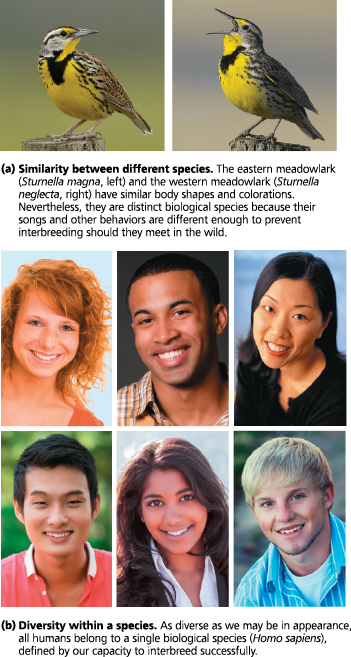
A reduction or lack of gene flow can play a key role in the formation of new ___
- species
}}Reproductive Isolation:}}
The existence of biological factors (barriers) that impede members of two species from producing viable, fertile offspring
Barriers that block gene flow between species also limit the formation of ___
- hybrids
}}Hybrid:}}
Offspring that results from the mating of individuals from two different species or from two true-breeding varieties of the same species
}}Prezygotic Barriers:}}
A reproductive barrier that impedes mating between species or hinders fertilization if interspecific mating is attempted
Identify prezygotic barriers
habitat, temporal, behavioral, mechanical, and gametic isolation
}}Habitat Isolation:}}
When organisms don’t reproduce due to living in different habitats
}}Temporal Isolation:}}
When organisms are awake or are reproducing at different times of day, year, or different seasons
}}Behavioral Isolation:}}
When organisms have unique courtship rituals
}}Mechanical Isolation:}}
When organisms can’t physically breed
}}Gametic Isolation:}}
When sperm won’t fuse and fertilize the egg
}}Postzygotic Barriers:}}
A reproductive barrier that prevents hybrid zygotes produced by two different species from developing into viable, fertile adults
Identify postzygotic barriers
Reduced hybrid viability, reduced hybrid fertility, and hybrid breakdown
}}Reduced Hybrid Viability:}}
When a hybrid has impaired development or survival
}}Reduced Hybrid Fertility:}}
When a hybrid is sterile (mule)
}}Hybrid Breakdown:}}
When first-generation hybrids are healthy but produce feeble or sterile offspring
Exploring Reproductive Barriers -

Why is the biological species concept limited to only some species?
There is no way to evaluate the reproductive isolation of fossils, and it doesn’t apply to asexually reproducing organisms.
In the biological species concept, species are designated by the ___ of gene flow. But there are many pairs of species that are morphologically and ecologically distinct, and yet gene flow _ between them
- absence; occurs
Hybridization between two species of bears in the genus Ursus

}}Morphological Species Concept:}}
Definition of a species in terms of measurable anatomical criteria
What are the pros and cons of the morphological species concept?
It can be applied to asexual and sexual organisms, it can be used without information on gene flow, but it deals with subjective criteria. Because it’s easy to observe, the morphological species concept is commonly used in the feild
}}Ecological Species Concept:}}
Definition of a species in terms of ecological niche, the sum of how members of the species interact with the nonliving an living parts of their environment
Unlike the biological species concept, the ecological species concept can accommodate ___ species. It also emphasizes the role of _ as organisms adapt to different environments
- asexual as well as sexual; disruptive natural selection
}}Phylogenetic Species Concept:}}
Definition of a species as the smallest group of individuals that share a common ancestor, forming one branch on the tree of life
What are the pros and cons of the phylogenetic species concept?
It can distinguish sufficiently differed groups to be separate species, but it is difficult to determine what degree of difference is considered a separate species
^^Which species concept(s) could you apply to both asexual and sexual species?^^
All except the biological species concept can be applied to both asexual and sexual species because they define species on the basis of characteristics other than the ability to reproduce. In contrast, the biological species concept can be applied only to sexual species
^^Which species concept would be most useful for identifying species in the field?^^
The easiest species concept to apply in the field would be the morphological species concept because it is based only on the appearance of the organism. Additional information about its ecological habits, evolutionary history, and reproduction is not required
^^Suppose you are studying two bird species that live in a forest and are not known to interbreed. One species feeds and mates in the treetops and the other on the ground. But in captivity, the birds can interbreed and produce viable, fertile offspring. What type of reproductive barrier most likely keeps these species separate in nature?^^
Because these birds live in fairly similar environments and can breed successfully in captivity, the reproductive barrier in nature is probably prezygotic; given the species’ differences in habitat preference, this barrier could result from habitat isolation
^^Explain the role of gene flow in the biological species concept^^
According to the biological species concept, a species is a group of populations whose members interbreed and produce viable, fertile offspring; thus, gene flow occurs between populations of a species. In contrast, members of different species do not interbreed, and hence no gene flow occurs between their populations. Overall, then, in the biological species concept, species can be viewed as designated by the absence of gene flow—making gene flow of central importance to the biological species concept
^^22.2 - Speciation can take place with or without geographic separation^^
In allopatric speciation, gene flow is reduced when two populations of one species become geographically separated from each other. One or both populations may undergo evolutionary change during the period of separation, resulting in the establishment of prezygotic or postzygotic barriers to reproduction
In sympatric speciation, a new species originates while remaining in the same geographic area as the parent species. Plant species (and, more rarely, animal species) have evolved sympatrically through polyploidy. Sympatric speciation can also result from habitat shifts and sexual selection
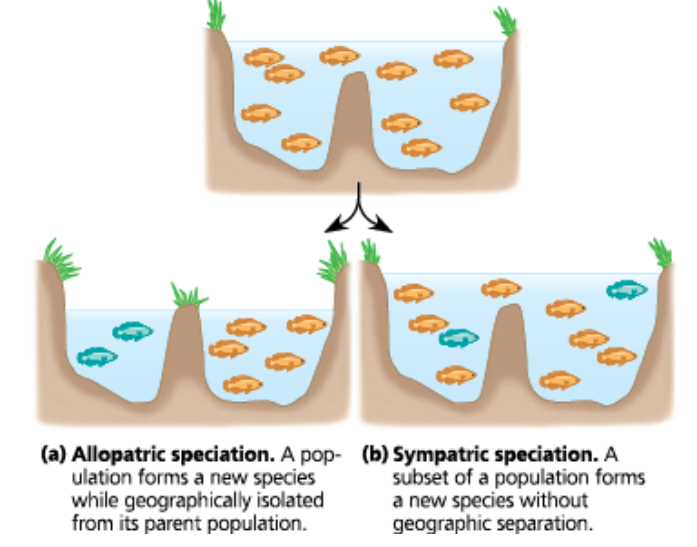
}}Allopatric Speciation:}}
The formation of new species in populations that are geographically isolated from one another
}}Sympatric Speciation:}}
The formation of new species in populations that live in the same geographic area
The geography of speciation
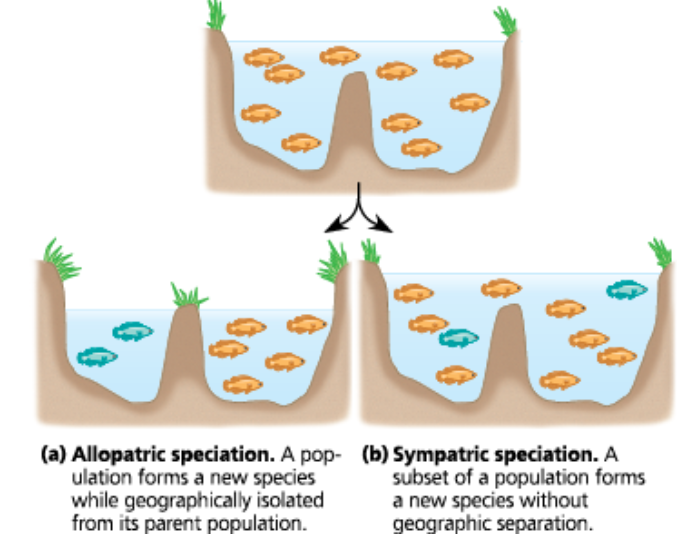
What barriers promote allopatric speciation?
The effectivity of a barrier is relative to different animals. Rivers may be barriers to some animals but not to animals that can swim or fly. Canyons are another example of barriers
Evolution in mosquitofish population - Different body shapes have evolved in mosquitofish populations from ponds with and without predators. These differences affect how quickly the fish can accelerate to escape and their survival rate when they are exposed to predators

Experiment - A researcher divided a laboratory population of the fruit fly Drosophila pseudoobscura, raising some flies on a starch medium and others on a maltose medium. After one year (about 40 generations), natural selection resulted in divergent evolution: Populations raised on starch digested starch more efficiently, while those raised on maltose digested maltose more efficiently. The researcher then put flies from the same or different populations in mating cages and measured mating frequencies. All flies used in the mating preference tests were reared for one generation on a standard cornmeal medium 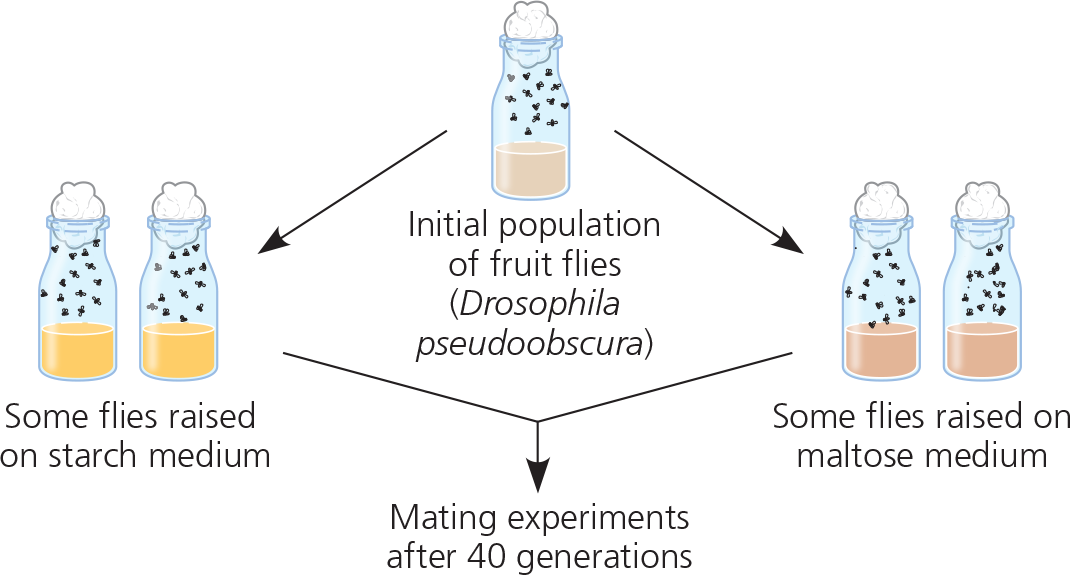
Results - Mating patterns among populations of flies raised on different media are shown below. When flies from “starch populations” were mixed with flies from “maltose populations,” the flies tended to mate with like partners. But in the control group (shown on the right), flies from different populations adapted to starch were about as likely to mate with each other as with flies from their own population; similar results were obtained for control groups adapted to maltose 
In the experimental group, the strong preference of “starch flies” and “maltose flies” to mate with like-adapted flies indicates that a ___ was forming between these fly populations. Although this barrier was not absolute (some mating between starch flies and maltose flies did occur), after 40 generations reproductive isolation appeared to be increasing. This barrier may have been caused by differences in courtship behavior that arose as an incidental by-product of differing _ as these allopatric populations adapted to different sources of food
- reproductive barrier; selective pressures
^^Why were all flies used in the mating preference tests reared on a standard medium (rather than on starch or maltose)?^^
If this had not been done, the strong preference of “starch flies” and “maltose flies” to mate with like-adapted flies could have occurred simply because the flies could detect (for example, by sense of smell) what their potential mates had eaten as larvae—and they preferred to mate with flies that had a similar smell to their own
}}Gene Flow:}}
The transfer of alleles from one population to another, resulting from the movement of fertile individuals or their gametes
How does immigration and emigration impact gene flow?
When new members (and their genes) enter a population, the overall balance of the gene pool is changed 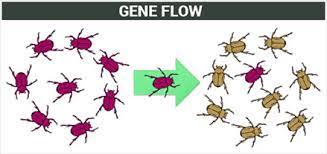
Allopatric speciation in snapping shrimp (Alpheus) - The shrimps pictured are just 2 of the 15 pairs of sister species that arose as populations were divided by the formation of the Isthmus of Panama. The color-coded type indicates the sister species
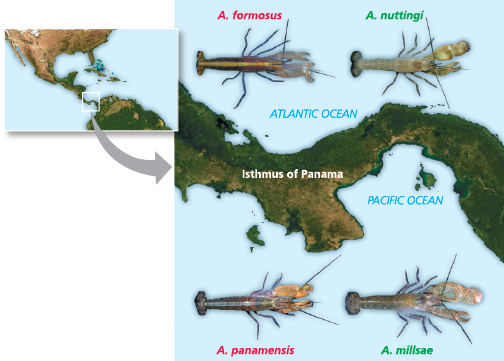
While geographic isolation prevents interbreeding between members of ___ populations, physical separation is not a biological barrier to reproduction
- allopatric
Biological reproductive barriers are ___ to organisms and prevent interbreeding when members of different populations _
- intrinsic; come into contact with one another
Sympatric speciation occurs when ___ is reduced by factors such as _
- gene flow; polyploidy, habitat differentiation, and sexual selection (mate’s choice)
}}Polyploidy:}}
A chromosomal alteration in which the organism possesses more than two complete chromosome sets
What is polyploidy caused by?
Accidents in cell division
}}Autopolyploid:}}
An individual that has more than two chromosome sets that are all derived from a single species
Sympatric speciation by autopolyploidy
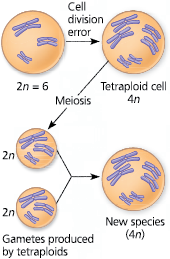
}}Allopolyploid:}}
A fertile individual that has more than two chromosome sets from different species
One mechanism for allopolyploid speciation in plants - Most hybrids are sterile because their chromosomes are not homologous and cannot pair during meiosis. However, such a hybrid may be able to reproduce asexually. This diagram traces one mechanism that can produce fertile hybrids (allopolyploids) as new species. The new species has a diploid chromosome number equal to the sum of the diploid chromosome numbers of the two parent species
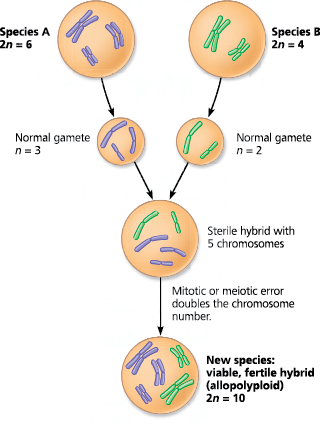
Is polyploidy more apparent in plants or animals?
Plants
Sympatric speciation can also occur when a subpopulation exploits a habitat or resource not used by the ___
- the parent population
Describe sexual selection
An organism (typically female) picks a mate based on appearance. For example, brightly patterned males are more easily spotted by predators, so they must have better genes otherwise. In sexual selection, females will choose to mate with colorful males for that reason. Also, physical appearance can also show how healthy an organism is (blue-footed boobies get color from the food they eat, so females will choose the males with the bluest feet)
Experiment - Researchers placed males and females of Pundamilia pundamilia and P. nyererei together in two aquarium tanks, one with natural light and one with a monochromatic orange lamp. Under normal light, the two species are noticeably different in male breeding coloration; under monochromatic orange light, the two species are very similar in color. The researchers then observed the mate choices of the females in each tank 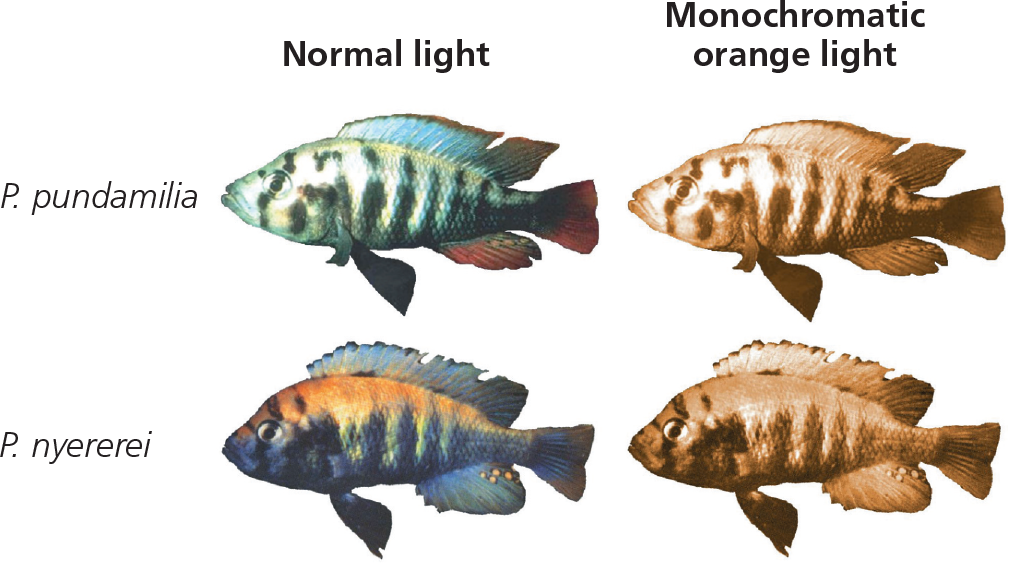
Results - Under normal light, females of each species strongly preferred males of their own species. But under orange light, females of each species responded indiscriminately to males of both species. The resulting hybrids were viable and fertile
The researchers concluded that mate choice by females based on male breeding coloration can act as a ___ that keeps the gene pools of these two species separate. Since the species can still interbreed when this prezygotic behavioral barrier is breached in the laboratory, the genetic divergence between the species is likely to be small. This suggests that speciation in nature has occurred _
- reproductive barrier; relatively recently
^^Suppose that female cichlids living in the murky waters of a polluted lake could not distinguish colors well. In such waters, how might the gene pools of these species change over time?^^
In murky waters where females distinguish colors poorly, females of each species might mate often with males of the other species. Hence, since hybrids between these species are viable and fertile, the gene pools of the two species could become more similar over time
In allopatric speciation, a new species forms in geographic isolation from its parent population which restricts ___
- gene flow
Once formed, ___ that arise in allopatric populations can prevent interbreeding with the parent population even if the populations come back into contact
- reproductive barriers
Sympatric speciation can occur when ___ to and from the isolated subpopulation is blocked by polyploidy, habitat differentiation, or sexual selection
- gene flow
^^Contrast allopatric and sympatric speciation. Which type of speciation is more common, and why?^^
In allopatric speciation, a new species forms while in geographic isolation from its parent species; in sympatric speciation, a new species forms in the absence of geographic isolation. Geographic isolation greatly reduces gene flow between populations, whereas ongoing gene flow is more likely in sympatric populations. As a result, sympatric speciation is less common than allopatric speciation
^^Is allopatric speciation more likely to occur on an island close to a mainland or on a more isolated island of the same size?^^
Allopatric speciation would be less likely to occur on an island near a mainland than on a more isolated island of the same size. We expect this result because continued gene flow between mainland populations and those on a nearby island reduces the chance that enough genetic divergence will take place for allopatric speciation to occur
^^Describe how an error during meiosis could lead to polyploidy^^
If all of the homologs failed to separate during anaphase I of meiosis, some gametes would end up with an extra set of chromosomes (and others would end up with no chromosomes). If a gamete with an extra set of chromosomes fused with a normal gamete, a triploid would result; if two gametes with an extra set of chromosomes fused with each other, a tetraploid would result
^^Can factors that cause sympatric speciation also cause allopatric speciation?^^
Sympatric speciation can be promoted by factors such as polyploidy, habitat shifts, and sexual selection, all of which can reduce gene flow between the subpopulations of a larger population. But such factors can also occur in allopatric populations and hence can also promote allopatric speciation
^^22.3 - Hybrid zones reveal factors that cause reproductive isolation^^
Many groups of organisms form hybrid zones in which members of different species meet and mate, producing at least some offspring of mixed ancestry
Many hybrid zones exhibit stability in that hybrid offspring continue to be produced over time. In others, reinforcement strengthens prezygotic barriers to reproduction, thus decreasing the formation of unfit hybrids. In still other hybrid zones, barriers to reproduction may weaken over time, resulting in the fusion of the species’ gene pools (reversing the speciation process)
}}Hybrid Zone:}}
A geographic region in which members of different species meet and mate, producing at least some offspring of mixed ancestry
A hybrid zone for Bombina toads in Europe - The graph shows the pattern of species-specific allele frequencies across the width of this narrow hybrid zone near Krakow, Poland. Individuals with frequencies close to 1 are yellow-bellied toads, individuals with frequencies close to 0 are fire-bellied toads, and individuals with intermediate frequencies are considered hybrids
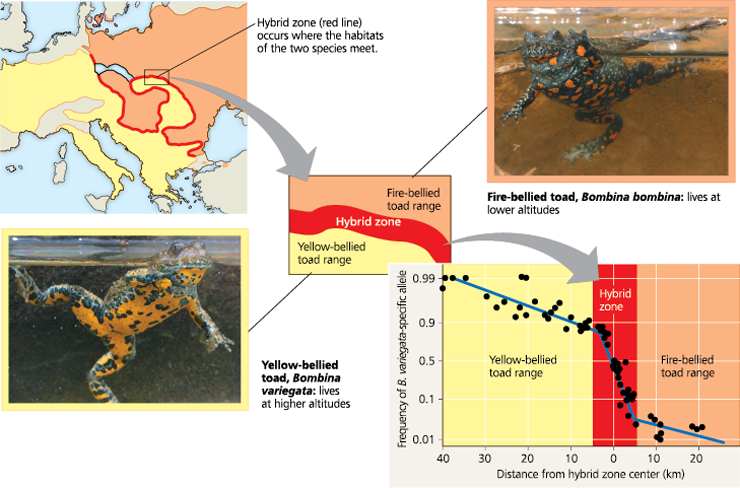
^^Does the graph indicate that gene flow is spreading fire-bellied toad alleles into the range of the yellow-bellied toad?^^
The graph suggests there has been gene flow of some fire-bellied toad alleles into the range of the yellow-bellied toad. Otherwise, all individuals located to the left of the hybrid zone portion of the graph would have allele frequencies close to 1
Why might hybrids be an obstacle to gene flow?
Hybrids may have more health. survival, or reproduction which prevents alleles from being passed from one species to another
If hybrids aren’t reproductively isolated from their parents, what’s the outcome of the hybrid zone over time?
It can result in the reinforcement of barriers, a fusion of species, or stability
Formation of a hybrid zone and possible outcomes for hybrids over time - Arrows represent the passage of time
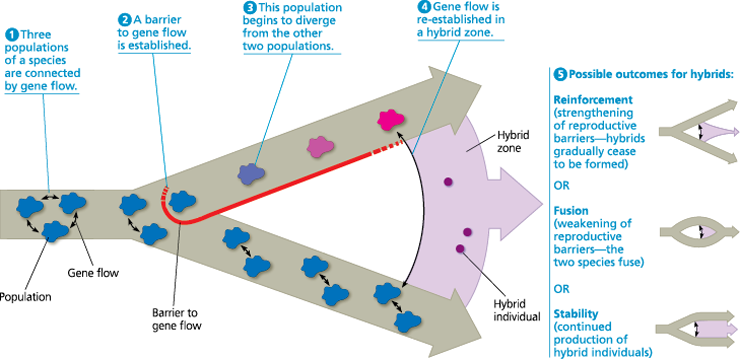
Predict what might happen if gene flow were re-established at step 3 in this process
Because the populations had only just begun to diverge from one another at this point in the process, it is likely that any existing barriers to reproduction would weaken over time
}}Reinforcement:}}
Natural selection strengthens prezygotic barriers which reduces the chance of hybrid formation
Reinforcement is likely when the hybrid offspring are less ___ than the parents
- fit
Barriers to reproduction between species should be stronger for (sympatric or allopatric) populations
sympatric
}}Fusion:}}
Gene flow that forms hyrbids weakens barriers to reproduction
Fusion causes gene pools to become more ___ until they fuse
- alike
Fusion: The breakdown of reproductive barriers - Increasingly cloudy water in Lake Victoria over the past several decades may have weakened reproductive barriers between P. nyererei and P. pundamilia. In areas of cloudy water, the two species have hybridized extensively, causing their gene pools to fuse
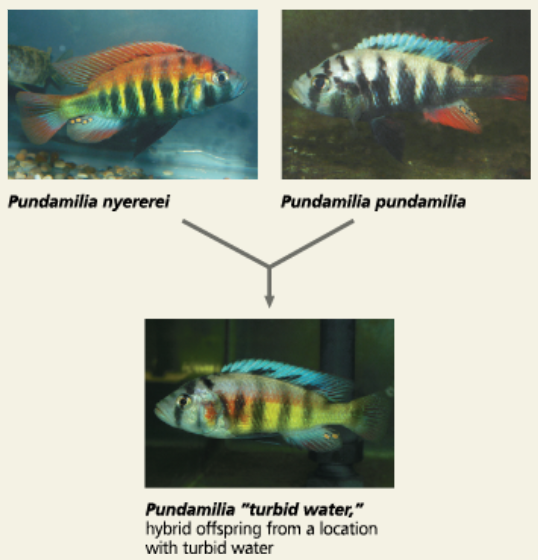
}}Stability:}}
When hybrids continue to be produced, persist, and stay stable over time in a hybrid zone
Stability is most common when the hybrids ___ better than either parent species
- survive or reproduce
^^What are hybrid zones, and why can they be viewed as “natural laboratories” in which to study speciation?^^
Hybrid zones are regions in which members of different species meet and mate, producing some offspring of mixed ancestry. Such regions can be viewed as “natural laboratories” in which to study speciation because scientists can directly observe factors that cause (or fail to cause) reproductive isolation
^^Consider two species that diverged while geographically separated but resumed contact before reproductive isolation was complete. Predict what would happen over time if the two species mated indiscriminately and hybrid offspring survived and reproduced more poorly than offspring from intraspecific matings or (b) hybrid offspring survived and reproduced as well as offspring from intraspecific matings^^
If hybrids consistently survived and reproduced poorly compared with the offspring of intraspecific matings, reinforcement could occur. If it did, natural selection would cause prezygotic barriers to reproduction between the parent species to strengthen over time, decreasing the production of unfit hybrids and leading to completion of the speciation process
^^Consider two species that diverged while geographically separated but resumed contact before reproductive isolation was complete. Predict what would happen over time if the two species mated indiscriminately and hybrid offspring survived and reproduced as well as offspring from intraspecific matings^^
If hybrid offspring survived and reproduced as well as the offspring of intraspecific matings, indiscriminate mating between the parent species would lead to the production of large numbers of hybrid offspring. As these hybrids mated with each other and with members of both parent species, the gene pools of the parent species could fuse over time, reversing the speciation process
^^What factors can support the long-term stability of a hybrid zone if the parent species live in different environments?^^
If the hybrids are selected against, the hybrid zone could persist if individuals from the parent species regularly travel into the zone, where they mate to produce hybrid offspring. If hybrids are not selected against, there is no cost to the continued production of hybrids, and large numbers of hybrid offspring may be produced. However, natural selection for life in different environments may keep the gene pools of the two parent species distinct, thus preventing the loss (by fusion) of the parent species and once again causing the hybrid zone to be stable over time
^^22.4 - Speciation can occur rapidly or slowly and can result from changes in few or many genes^^
New species can form rapidly once divergence begins—but it can take millions of years for that to happen. The time interval between speciation events varies considerably, from a few thousand years to tens of millions of years
New developments in genetics have enabled researchers to identify specific genes involved in some cases of speciation. Results show that speciation can be driven by few or many genes
What can the fossil record show?
It can show when new species appear suddenly in a geologic stratum, persist essentially unchanged through several strata, and then disappear
}}Punctuated Equilibria:}}
In the fossil record, long periods of apparent stasis, in which a species undergoes little or no morphological change interrupted by relatively brief periods of sudden change
Two models for the temp of speciation

A punctuated pattern indicates that speciation occurred relatively ___
- rapidly
A hybrid sunflower species and its dry sand dune habitat - The wild sunflower Helianthus anomalus shown here originated via the hybridization of two other sunflowers, H. annuus and H. petiolaris, which live in nearby but moister environments

Researchers crossed the two parent sunflower species, H. annuus and H. petiolaris, to produce in the laboratory (for each gamete, only two of the n = 17 chromosomes are shown) 
- experimental hybrids
What were the results of the experiment?
Although only 5% of the F1 experimental hybrids were fertile, after just four more generations the hybrid fertility rose to more than 90%. The chromosomes of individuals from this fifth hybrid generation differed from those in the F1 generation (see above) but were similar to those in H. anomalus individuals from natural populations 
Over time, the chromosomes in the population of experimental hybrids became similar to the chromosomes of H. anomalus individuals from natural populations. This suggests that the observed rise in the fertility of the experimental hybrids may have occurred as ___ eliminated regions of DNA from the parent species that were not compatible with one another. Overall, it appeared that the initial steps of the speciation process occurred _ and could be mimicked in a laboratory experiment
- selection; rapidly
^^The increased fertility of the experimental hybrids could have resulted from natural selection for thriving under laboratory conditions. Evaluate this alternative explanation for the result^^
Over time, the chromosomes of the experimental hybrids came to resemble those of H. anomalus. This occurred even though conditions in the laboratory differed greatly from conditions in the field, where H. anomalus is found, suggesting that selection for laboratory conditions was not strong. Thus, it is unlikely that the observed rise in the fertility of the experimental hybrids was due to selection for life under laboratory conditions
New species can arise rapidly once ___ begnis
- divergence
Speciation begins only after ___ between populations is interrupted, perhaps by changing environmental conditions or by unpredictable events, such as a storm that transports a few individuals to a new area
- gene flow
Once gene flow is interrupted, the populations must diverge genetically to such an extent that they become ___ —all before other events cause gene flow to resume, possibly reversing the speciation process
- reproductively isolated
How can reproductive isolation result from a small amount of genes?
In some snails, one gene determines the shell spiral which can be a mechanical barrier
A locus that influences pollinator choice - Pollinator preferences provide a strong barrier to reproduction between Mimulus lewisii and M. cardinalis. After transferring the M. lewisii allele for a flower-color locus into M. cardinalis and vice versa, researchers observed a shift in some pollinators’ preferences
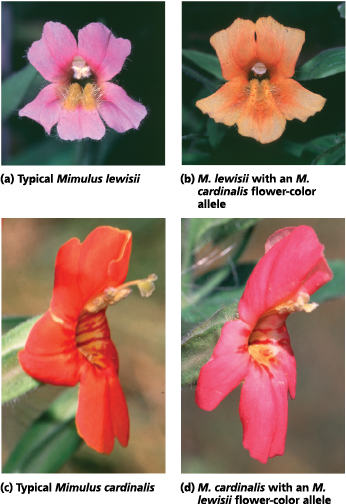
^^If M. cardinalis individuals that had the M. lewisii yup allele were planted in an area that housed both monkey flower species, how might the production of hybrid offspring be affected?^^
The presence of M. cardinalis plants that carry the M. lewisii yup allele would make it more likely that bumblebees would transfer pollen between the two monkey flower species. As a result, we would expect the number of hybrid offspring to increase
How can reproductive isolation result from a large amount of genes?
In some fruit flies, hybrid sterility results from gene interactions among at least four loci, and postzygotic isolation in the sunflower hybrid zone discussed earlier is influenced by at least 26 chromosome segments
As speciation occurs again and again, such differences can ___, eventually leading to the formation of new groups of organisms that _ from their ancestors
- accumulate and become more pronounced; differ greatly
^^Speciation can occur rapidly between diverging populations, yet the time between speciation events is often more than a million years. Explain this apparent contradiction^^
The time between speciation events includes (1) the length of time that it takes for populations of a newly formed species to begin diverging reproductively from one another and (2) the time it takes for speciation to be complete once this divergence begins. Although speciation can occur rapidly once populations have begun to diverge from one another, it may take millions of years for that divergence to begin
^^Summarize evidence that the yup flower-color locus acts as a prezygotic barrier to reproduction in two species of monkey flowers. Do these results demonstrate that the yup locus alone controls barriers to reproduction between these species?^^
Investigators transferred alleles at the yup locus (which influences flower color) from each parent species to the other. M. lewisii plants with an M. cardinalis yup allele received many more visits from hummingbirds than usual; hummingbirds usually pollinate M. cardinalis but avoid M. lewisii. Similarly, M. cardinalis plants with an M. lewisii yup allele received many more visits from bumblebees than usual; bumblebees usually pollinate M. lewisii and avoid M. cardinalis. Thus, alleles at the yup locus can influence pollinator choice, which in these species provides the primary barrier to interspecific mating. Nevertheless, the experiment does not prove that the yup locus alone controls barriers to reproduction between M. lewisii and M. cardinalis; other genes might enhance the effect of the yup locus (by modifying flower color) or cause entirely different barriers to reproduction (for example, gametic isolation or a postzygotic barrier)
^^Compare Figure 10.11 with Figure 22.18. What cellular process could cause the hybrid chromosomes in Figure 22.18 to contain DNA from both parent species?^^
Crossing over. If crossing over did not occur, each chromosome in an experimental hybrid would remain as in the F1 generation: composed entirely of DNA from one parent species or the other
^^Is speciation something that happened only in the distant past, or are new species continuing to arise today?^^
As the goatsbeard plant, Bahamas mosquitofish, and apple maggot fly illustrate, speciation continues to happen today. A new species can begin to form whenever gene flow is reduced between populations of the parent species. Such reductions in gene flow can occur in many ways: A new, geographically isolated population may be founded by a few colonists; some members of the parent species may begin to utilize a new habitat; and sexual selection may isolate formerly connected populations or subpopulations. These and many other such events are happening today